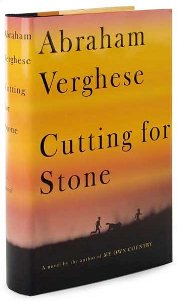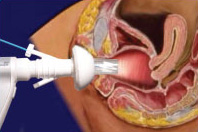
Gynaecology or gynecology is the area of medicine that involves the treatment of women's diseases, especially those of the reproductive organs. It is often paired with the field of obstetrics, forming the combined area of obstetrics and gynaecology (OB-GYN).

Charles Everett Koop was an American pediatric surgeon and public health administrator who served as the 13th surgeon general of the United States under President Ronald Reagan from 1982 to 1989. According to the Associated Press, "Koop was the only surgeon general to become a household name" due to his frequent public presence around the HIV/AIDS crisis of the 1980s.
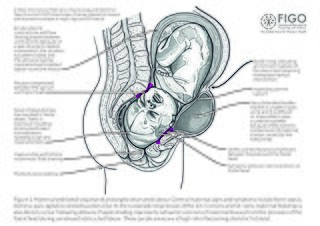
Obstetric fistula is a medical condition in which a hole develops in the birth canal as a result of childbirth. This can be between the vagina and rectum, ureter, or bladder. It can result in incontinence of urine or feces. Complications may include depression, infertility, and social isolation.
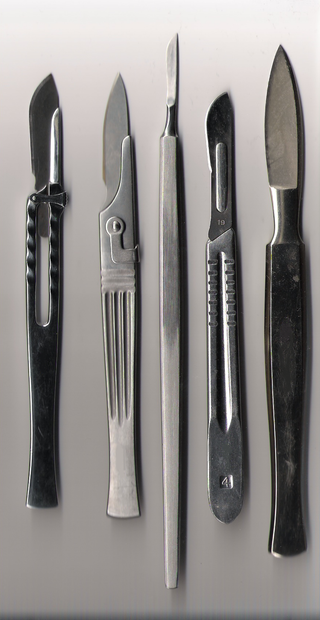
A surgical instrument is a medical device for performing specific actions or carrying out desired effects during a surgery or operation, such as modifying biological tissue, or to provide access for viewing it. Over time, many different kinds of surgical instruments and tools have been invented. Some surgical instruments are designed for general use in all sorts of surgeries, while others are designed for only certain specialties or specific procedures.

Pediatric surgery is a subspecialty of surgery involving the surgery of fetuses, infants, children, adolescents, and young adults.

James Marion Sims was an American physician in the field of surgery. His most famous work was the development of a surgical technique for the repair of vesicovaginal fistula, a severe complication of obstructed childbirth. He is also remembered for inventing the Sims speculum, Sims sigmoid catheter, and the Sims position. Against significant opposition, he established, in New York, the first hospital specifically for women. He was forced out of the hospital he founded because he insisted on treating cancer patients; he played a small role in the creation of the nation's first cancer hospital, which opened after his death.
John of Arderne (1307–1392) was an English surgeon, and one of the first of his time to devise some workable cures. He is considered one of the fathers of surgery, described by some as England's first surgeon and by others as the country's first "of note". Many of his treatments are still in use today. Arderne's help was given to both the rich and the poor. His view on fees was that rich men should be charged as much as possible, but poor men should be remedied free of charge. His remedies for illness are considered substantial for his time. Arderne recommended opium as a soporific and as an external anesthetic that the patient "shal sleep so that he shal feel no cutting". In his document about Fistula in ano, John of Arderne sets out not only his operative procedures but also his code of conduct for the ideal medical practitioner.
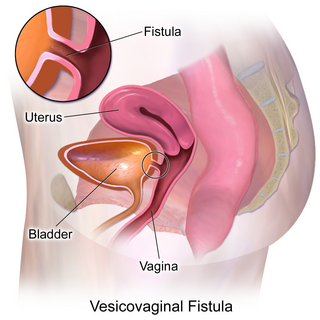
Vesicovaginal fistula (VVF) is a subtype of female urogenital fistula (UGF).

Anal fistula is a chronic abnormal communication between the anal canal and the perianal skin. An anal fistula can be described as a narrow tunnel with its internal opening in the anal canal and its external opening in the skin near the anus. Anal fistulae commonly occur in people with a history of anal abscesses. They can form when anal abscesses do not heal properly.
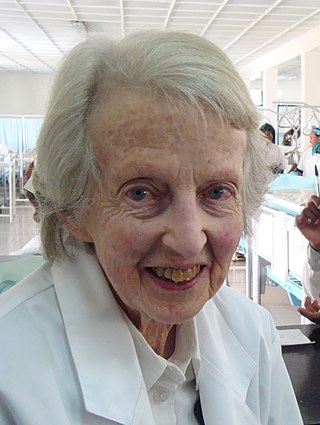
Elinor Catherine Hamlin, AC, FRCS, FRANZCOG, FRCOG was an Australian obstetrician and gynaecologist who, with her husband, New Zealander Reginald Hamlin, co-founded the Addis Ababa Fistula Hospital, the world's only medical centre dedicated exclusively to providing free obstetric fistula repair surgery to poor women with childbirth injuries. They also co-founded an associated non-profit organisation, Hamlin Fistula Ethiopia.

Abraham Verghese is an American physician, author and Professor of the Theory and Practice of Medicine and Vice Chair of Education at Stanford University Medical School. He is the author of four best-selling books: two memoirs and two novels. In 2011, he was elected to be a member of the Institute of Medicine. He received the National Humanities Medal from President Barack Obama in 2015. He is the co-host with Eric Topol of the podcast Medscape Medicine and the Machine.
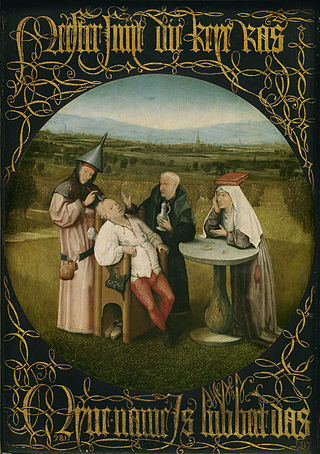
Surgery is the branch of medicine that deals with the physical manipulation of a bodily structure to diagnose, prevent, or cure an ailment. Ambroise Paré, a 16th-century French surgeon, stated that to perform surgery is, "To eliminate that which is superfluous, restore that which has been dislocated, separate that which has been united, join that which has been divided and repair the defects of nature."

Fistula Foundation is a nonprofit 501(c)(3) organization focused on treatment of obstetric fistula, funding more repair surgeries than any other organization, public or private. As of September 2022, they support hospitals and doctors in over 20 countries across Africa and Asia. The foundation is dedicated to treating obstetric fistula by covering the full cost of fistula repair surgery for poor women who would otherwise not be able to access treatment. They also provide fistula surgeon training, equipment and facility upgrades that make fistula treatment as safe as possible, post-surgery counseling and support for healed patients. The foundation has been recognized by several organizations for its transparency, effectiveness and efficiency, earning a top "A" rating from CharityWatch and a four star rating from Charity Navigator for 16 years in a row, placing it in the top 1% of charities reviewed on the site. In 2023, the foundation received a $15 million gift from philanthropist MacKenzie Scott, announced alongside a new five-year strategic plan that will advance the foundation's In It to End It vision. The foundation has also been selected as one of 22 charities recommended by Princeton Professor Peter Singer's organization, The Life You Can Save. The organization's cost-effectiveness was also noted by GiveWell in 2019.
Urogynecology or urogynaecology is a surgical sub-specialty of urology and gynecology.

Addis Ababa Fistula Hospital, also known as AAFH and Hamlin Fistula Hospital, is a women's health care hospital based in Addis Ababa, Ethiopia. The hospital was founded by Australian physicians Catherine Hamlin and Reginald Hamlin, to care for women with childbirth injuries. It is the only hospital of its kind dedicated exclusively to treating women with obstetric fistula, a condition in the developing world where maternal health provisions are poor. All patients are treated free of charge.

Pradeep Kumar Chowbey is an Indian surgeon, known for laparoscopic and bariatric surgeries. He is the incumbent Executive vice chairman of the Max Healthcare, Chairman of the Minimal Access, Metabolic & Bariatric Surgery and Allied Surgical Specialities of the Max Healthcare Institute, New Delhi. He is the founder of the Minimal Access, Metabolic & Bariatric Surgery Centre at the Sir Ganga Ram Hospital, New Delhi and has served as the Honorary Surgeon to the President of India, Dalai Lama and the Indian Armed Forces (AFMS). The Government of India awarded him the fourth highest civilian honour of the Padma Shri in 2002.
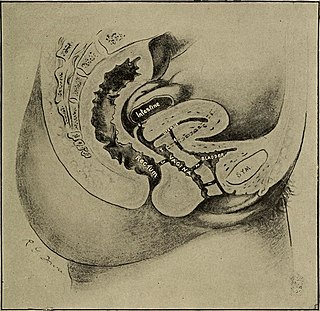
A ureterovaginal fistula is an abnormal passageway existing between the ureter and the vagina. It presents as urinary incontinence. Its impact on women is to reduce the "quality of life dramatically."

Willis John Potts was an American pediatric surgeon and one of the earliest physicians to focus on the surgical treatment of heart problems in children. Potts set up one of the country's first pediatric surgery programs at Children's Memorial Hospital in Chicago.

Ian Aird was a Scottish surgeon who became Professor of Surgery at the Royal Postgraduate Medical School in London. There he built up a large and productive research department which made particular contributions in cardiac surgery, renal transplantation and the association of blood groups with stomach cancer. He came to national and international prominence in 1953 when he led the teams which performed an operation to separate conjoined twins. His book A Companion in Surgical Studies was among the best selling surgical textbooks of its day. He died suddenly in 1962 at the age of 57.
Anarcha Westcott was an enslaved woman who underwent a series of experimental surgical procedures conducted by physician J. Marion Sims, without the use of anesthesia, to treat a combination of vesicovaginal fistula and rectovaginal fistula. Sims's medical experimentation with Anarcha and other enslaved women, and its role in the development of modern gynaecology, has generated controversy among medical historians.
